Related Research Articles

Dacia was the land inhabited by the Dacians, its core in Transylvania, stretching to the Danube in the south, the Black Sea in the east, and the Tisza in the west. The Carpathian Mountains were located in the middle of Dacia. It thus roughly corresponds to present-day Romania, as well as parts of Moldova, Bulgaria, Serbia, Hungary, Slovakia, and Ukraine.

Moesia was an ancient region and later Roman province situated in the Balkans south of the Danube River. Moesian Province was first administered by governor of Noricum as 'Civitates of Moesia and Triballia'. It included most of the territory of modern eastern Serbia, Kosovo, north-eastern Albania, northern parts of North Macedonia, Northern Bulgaria, Romanian Dobruja and small parts of Southern Ukraine.

The Dacians were the ancient Indo-European inhabitants of the cultural region of Dacia, located in the area near the Carpathian Mountains and west of the Black Sea. They are often considered a subgroup of the Thracians. This area includes mainly the present-day countries of Romania and Moldova, as well as parts of Ukraine, Eastern Serbia, Northern Bulgaria, Slovakia, Hungary and Southern Poland. The Dacians and the related Getae spoke the Dacian language, which has a debated relationship with the neighbouring Thracian language and may be a subgroup of it. Dacians were somewhat culturally influenced by the neighbouring Scythians and by the Celtic invaders of the 4th century BC.
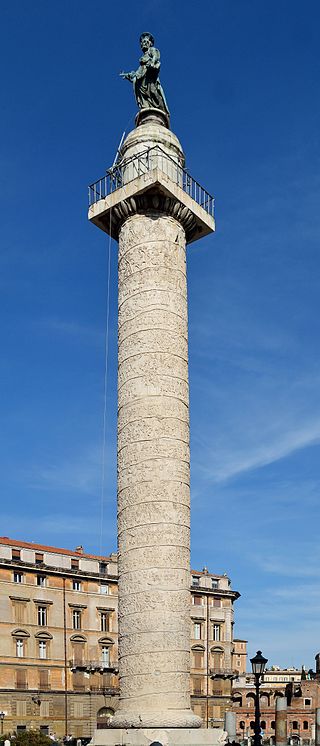
Trajan's Column is a Roman triumphal column in Rome, Italy, that commemorates Roman emperor Trajan's victory in the Dacian Wars. It was probably constructed under the supervision of the architect Apollodorus of Damascus at the order of the Roman Senate. It is located in Trajan's Forum, north of the Roman Forum. Completed in AD 113, the freestanding column is most famous for its spiral bas relief, which depicts the wars between the Romans and Dacians. Its design has inspired numerous victory columns, both ancient and modern.

Dacian is an extinct language generally believed to be a member of the Indo-European language family that was spoken in the ancient region of Dacia.

The Scordisci were an Iron Age cultural group who emerged after the Celtic settlement of Southeast Europe, and who were centered in the territory of present-day Serbia, at the confluence of the Savus (Sava), Dravus (Drava), Margus (Morava) and Danube rivers. They were historically notable from the beginning of the third century BC until the turn of the common era, and consolidated into a tribal state. At their zenith, their core territory stretched over regions comprising parts of present-day Serbia, Croatia, Bulgaria and Romania, while their influence spread even further. After the Roman conquest in the 1st century AD, their territories were included into the Roman provinces of Pannonia, Moesia and Dacia.

The Dardani or Dardanians were a Paleo-Balkan people, who lived in a region that was named Dardania after their settlement there. They were among the oldest Balkan peoples, and their society was very complex. The Dardani were the most stable and conservative ethnic element among the peoples of the central Balkans, retaining an enduring presence in the region for several centuries.

The so-called Free Dacians is the name given by some modern historians to those Dacians who putatively remained outside, or emigrated from, the Roman Empire after the emperor Trajan's Dacian Wars. Dio Cassius named them Dakoi prosoroi meaning "neighbouring Dacians".

Trajan's First Dacian War took place from 101 to 102.

Dardania was a Roman province in the Central Balkans, initially an unofficial region in Moesia (87–284), and then a province administratively part of the Diocese of Moesia (293–337). It was named after the tribe of the Dardani who inhabited the region in classical antiquity prior to the Roman conquest.

Much of the territory of the modern state of Serbia was part of the Roman Empire and later the Eastern Roman Empire. In particular, the region of Central Serbia was under Roman rule for about 800 years, starting from the 1st century BC, interrupted by the arrival of the Slavs into the Balkans during the 6th century, but continued after fall of the First Bulgarian Empire in the early 11th century and permanently ended with the rise of the Second Bulgarian Empire in the late 12th century. The territories were administratively divided into the provinces of Moesia, Pannonia and Dardania. Moesia Superior roughly corresponds to modern Serbia proper; Pannonia Inferior included the eastern part of Serbia proper; Dardania included the western part of Serbia proper. After its reconquest from the Bulgarians by Emperor Basil II in 1018, it was reorganized into the Theme of Bulgaria.
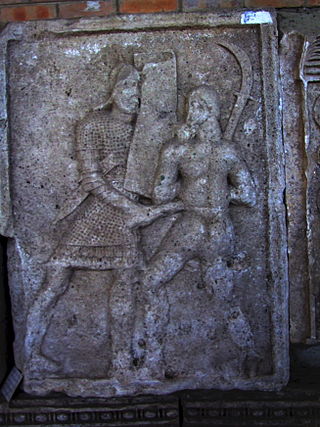
The history of Dacian warfare spans from c. 10th century BC up to the 2nd century AD in the region defined by Ancient Greek and Latin historians as Dacia, populated by a collection of Thracian, Ionian, and Dorian tribes. It concerns the armed conflicts of the Dacian tribes and their kingdoms in the Balkans. Apart from conflicts between Dacians and neighboring nations and tribes, numerous wars were recorded among Dacians too.

Argidava was a Dacian fortress town close to the Danube, inhabited and governed by the Albocense. Located in today's Vărădia, Caraș-Severin County, Romania.
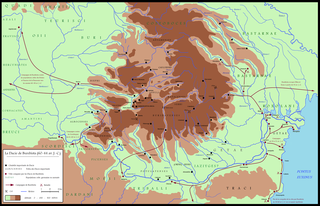
Dava was a Geto-Dacian name for a city, town or fortress. Generally, the name indicated a tribal center or an important settlement, usually fortified. Some of the Dacian settlements and the fortresses employed the Murus Dacicus traditional construction technique.
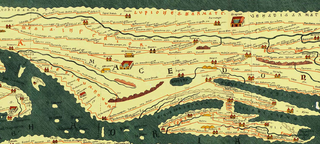
Amutria was a Dacian town close to the Danube and included in the Roman road network, after the conquest of Dacia.
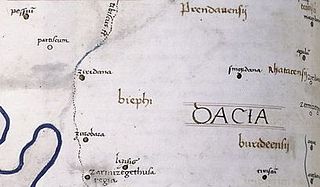
Ziridava was a Dacian town located between Apulon and Tibiscum, mentioned by Ptolemy in the area of the Dacian tribe of Biephi.
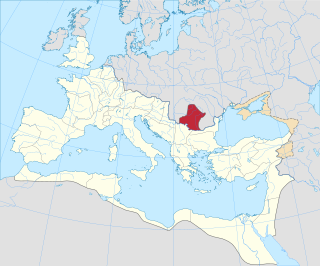
Roman Dacia was a province of the Roman Empire from 106 to 271–275 AD. Its territory consisted of what are now the regions of Oltenia, Transylvania and Banat. During Roman rule, it was organized as an imperial province on the borders of the empire. It is estimated that the population of Roman Dacia ranged from 650,000 to 1,200,000. It was conquered by Trajan (98–117) after two campaigns that devastated the Dacian Kingdom of Decebalus. However, the Romans did not occupy its entirety; Crișana, Maramureș, and most of Moldavia remained under the Free Dacians.
References
- ↑ Vasiljević 2014, p. 11.
- ↑ Papazoglu 1978, p. 251.
- ↑ Lepper 1988 , p. 138:Stuart Jones noted the Dacian - sounding place - name ' Thermidava ' on the Lissus Naissus road : but see Miller col . 557 , for the evidence on this. The place was most probably called ' Theranda ' and there is no evidence for any settlement there of pro-Roman Dacians now, nor is it very likely. (..) Most scholars , however , have supposed , as did Cichorius , that we are now north of the Danube , somewhere in the Banat area where the local inhabitants are frightened that they may lose their recently acquired 'liberty'.
